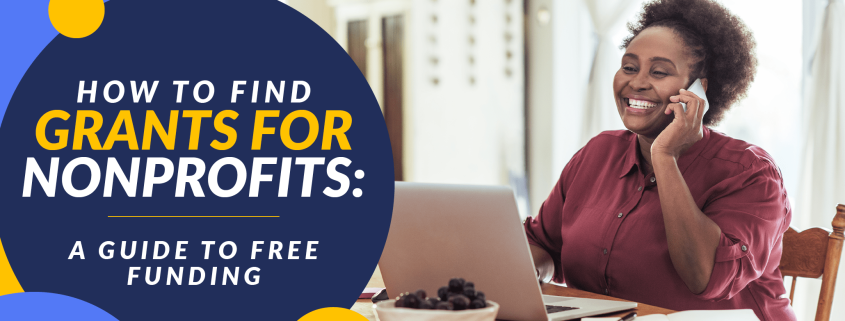How to Find Grants for Nonprofits: A Guide to Free Funding
From capital support to marketing assistance, grants provide many opportunities for boosting the success of your nonprofit. After all, your organization needs steady funding to continue furthering its mission and finding better ways to make a difference in the lives of those you serve.
With the right approach, you can build lasting relationships with grantmakers and secure significant revenue to propel your projects forward. In this guide, we’ll walk through how to find grants for nonprofits in detail, so you have everything you need to begin pursuing these impactful opportunities. Here’s what we’ll cover:
- Grants for Nonprofits: FAQs
- How to Find Grants for Nonprofits: 5 Steps
- 5 Best Practices for Finding Nonprofit Grants
- Finding Grants for Nonprofits: 14 Resources
For 11 consecutive years, giving from foundations has grown, reaching a total of $90.88 billion in 2021. This means that it’s an ideal time to start searching for grants that will accelerate your organization’s impact. Let’s get started with all you need to know about finding nonprofit grants.
Grants for Nonprofits: FAQs
Your nonprofit’s long-term success depends on diversifying its funding sources. If you’ve decided that it’s time to add grants to the mix, it’s important to first understand the ins and outs of this type of funding to learn how it will best fit into your current strategy.
What are grants for nonprofits?
Nonprofit grants are financial gifts that grantmaking organizations provide to nonprofits, typically for a specific purpose or initiative.
In order to receive this funding, however, your organization will need to fulfill the grantmaker’s specific requirements and submit an application. It’s ultimately up to the grantmaking organization to decide whether or not they’d like to support your nonprofit.
What types of nonprofit grants are there?
There are several types of nonprofit grants. By understanding how they differ from one another, you’ll be able to focus on the specific grants that best serve the needs of your organization. The five main types of grants include:
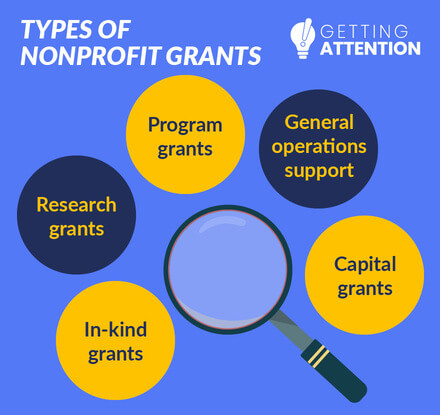
- Program grants. Program development grants provide funding for specified projects or programs, such as upgrading your nonprofit’s technology. Because of this, they usually have spending restrictions. Recipients of these grants may only use the funds for the exact purpose outlined in their grant proposal.
- General operations support. These grants are far less restrictive than program development grants and cover almost any expense for your organization. However, general operations support grants are much rarer in the nonprofit sphere.
- Capital grants. These grants are most commonly awarded for specific capital campaigns that involve activities such as building construction, property acquisition, or other large-scale projects.
- Research grants. For academia and research-oriented nonprofits, research grants support their scientific research and are often attached to a specific team member in the organization.
- In-kind grants. In-kind grants provide non-monetary assistance, such as equipment, supplies, or free counseling and personnel. The Google Ad Grants program, for instance, is a popular in-kind grant opportunity that offers nonprofits a monthly allowance of $10,000 in Google Ads credit.
Since each type of grant contributes to the success of your organization in a different way, be sure to keep these distinctions in mind when finding nonprofit grants. This ensures that you only apply for the opportunities that will benefit your nonprofit the most.
Where do grants for nonprofits come from?
When looking for grants to apply for, you need to learn to distinguish between the various sources of grant funding to set your organization up for success. The most common sources of nonprofit grants are:

The Government
There are various levels in the government grant funnel that offer valuable funding opportunities. For instance, nonprofits across the country can receive federal grants. However, nonprofits can only apply for state grants in the particular state to which they belong. Local grants are further limited to a specific community or district within a state.
There are no restrictions on how many government grants a nonprofit can research and pursue. As long as you’ve determined that your organization meets the eligibility criteria, you can apply for as many of these opportunities as you see fit.
Foundations
These organizations play a significant role in supporting nonprofits, accounting for 19% of all charitable giving in 2021. The two main categories of foundations are private foundations and public charities, though organizations in both categories supply grant funds to nonprofits.
While a private foundation typically acquires its funds from a single individual or a family, public charities receive financial support from a variety of sources, including government agencies and program service fees. Some of the most notable foundations that provide funding opportunities to nonprofit organizations include the Ford Foundation and the Bill & Melinda Gates Foundation.
Corporations
Corporate grants are a vital source of funding for nonprofits, providing financial support for programs, initiatives, and services that align with a company’s philanthropic goals. Unlike sponsorships or donations, corporate grants are typically more structured and formal, often requiring nonprofits to submit detailed applications or proposals. These grants can be targeted toward specific projects, operating costs, or capacity-building efforts, making them an important component of a nonprofit’s funding strategy.
As a result, many corporations allocate portions of their profits toward their corporate giving initiatives. The Google Ad Grants program is a clear example of a large corporation offering resources and assistance to nonprofits, with Google donating valuable ad space that most businesses pay thousands of dollars to obtain.
Some businesses also offer matching gifts and corporate volunteer grants, which provide funding to nonprofits after an employee gives to or volunteers a certain number of hours with the organization. Over 65% of Fortune 500 companies offer these programs, including Microsoft, Disney, Bank of America, FedEx, Home Depot, and more.
Federated Funds
Local businesses and company employees raise these funds to distribute to nonprofits. This type of “community chest” model can be a significant source of revenue. While it’s often easy for donors to give to federated funds, it’s crucial for organizations to apply for this funding early to increase their chances of securing some of these resources.
What are the advantages and disadvantages of grants?
As with any fundraising initiative, it’s necessary to weigh the pros and cons before you start pursuing nonprofit grant opportunities. Some important considerations include:
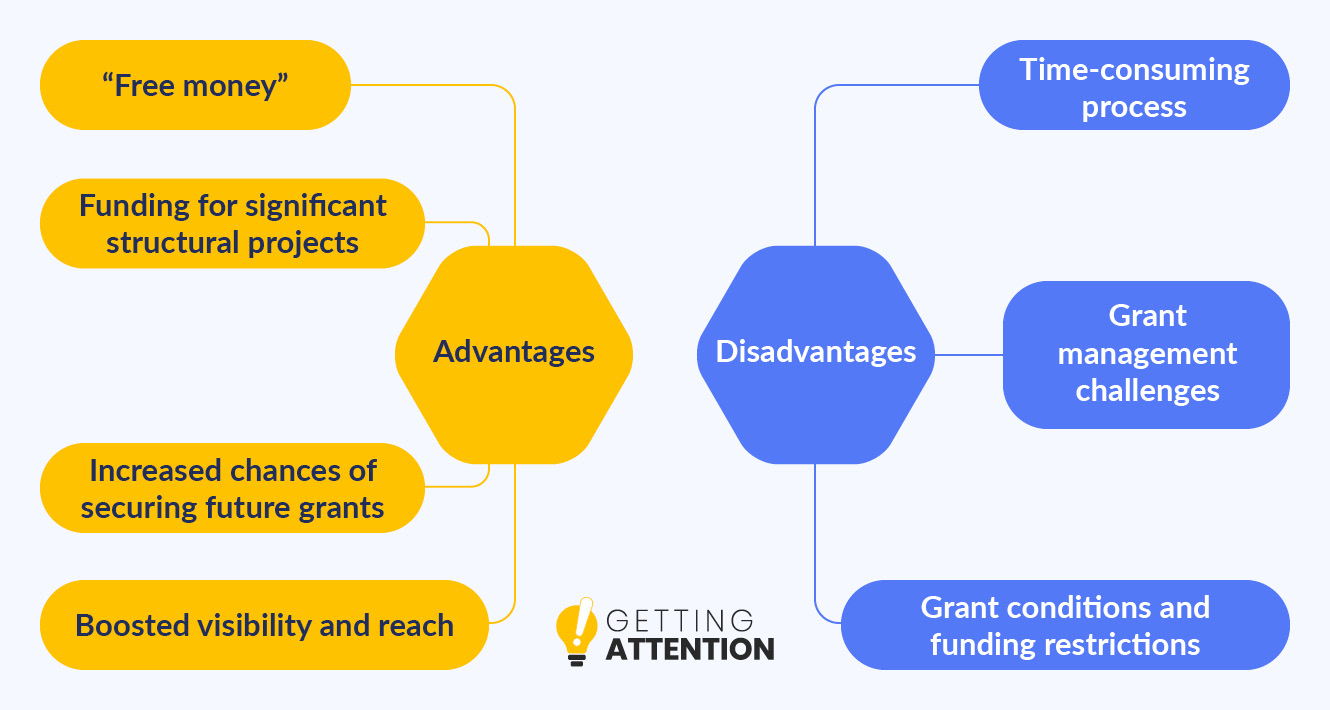
Advantages:
- Essentially, grants provide “free money” to nonprofits.
- Grants can power significant structural projects, enabling organizations to achieve large-scale social impact and further their overall missions.
- Securing one grant makes it more likely to secure more in the future, since it builds your organization’s credibility.
- Grants can boost your nonprofit’s visibility and reach, allowing you to win the trust of current and prospective donors.
Disadvantages:
- The process of finding nonprofit grants and applying for them can be time-consuming, since writing effective grant proposals requires skills and thought.
- It can be challenging to manage various expectations associated with receiving and managing a grant, such as reporting requirements.
- Many grants, such as program development grants, come with conditions and funding restrictions.
Fortunately, your nonprofit can cut down on many of these disadvantages by addressing them upfront. For instance, adopting grant management software can make it easier to keep track of all of your grant-related efforts, saving you time and energy in the process.
Should I apply for a nonprofit grant?
Once you’ve considered nonprofit grant types, their common sources, and their associated advantages and disadvantages, it’s time to determine whether your organization should apply for these funding opportunities. Use these questions to guide you:
- Are you able to invest the necessary time and effort into writing a winning grant application?
- Are the activities you’re planning to undertake with grant funding consistent with your nonprofit’s mission and overall strategy?
- Can you continue these activities after grant funding has ended?
- How would a grant be vital to the success of your nonprofit or initiative?
- Do you have enough qualified staff in place to implement your initiative?
- How will grants fit into your overall fundraising strategy?
- Do you have proven positive outcomes related to past work that you can show grantmakers?
Keep your nonprofit’s short- and long-term goals in mind when searching for and deciding to apply for grants. Make the most of your efforts by focusing only on opportunities that match your specific needs. For instance, if you’re hoping to leverage grant money to enhance your marketing, you might consider applying for the Google Ad Grant, which will supply you with funds to spend on digital ads.
How to Find Grants for Nonprofits: 5 Steps
The process of finding grants that are the right fit for your organization does not have to be complicated or confusing. By following these steps, you’ll be well on your way to securing funds that will amplify your nonprofit’s impact.
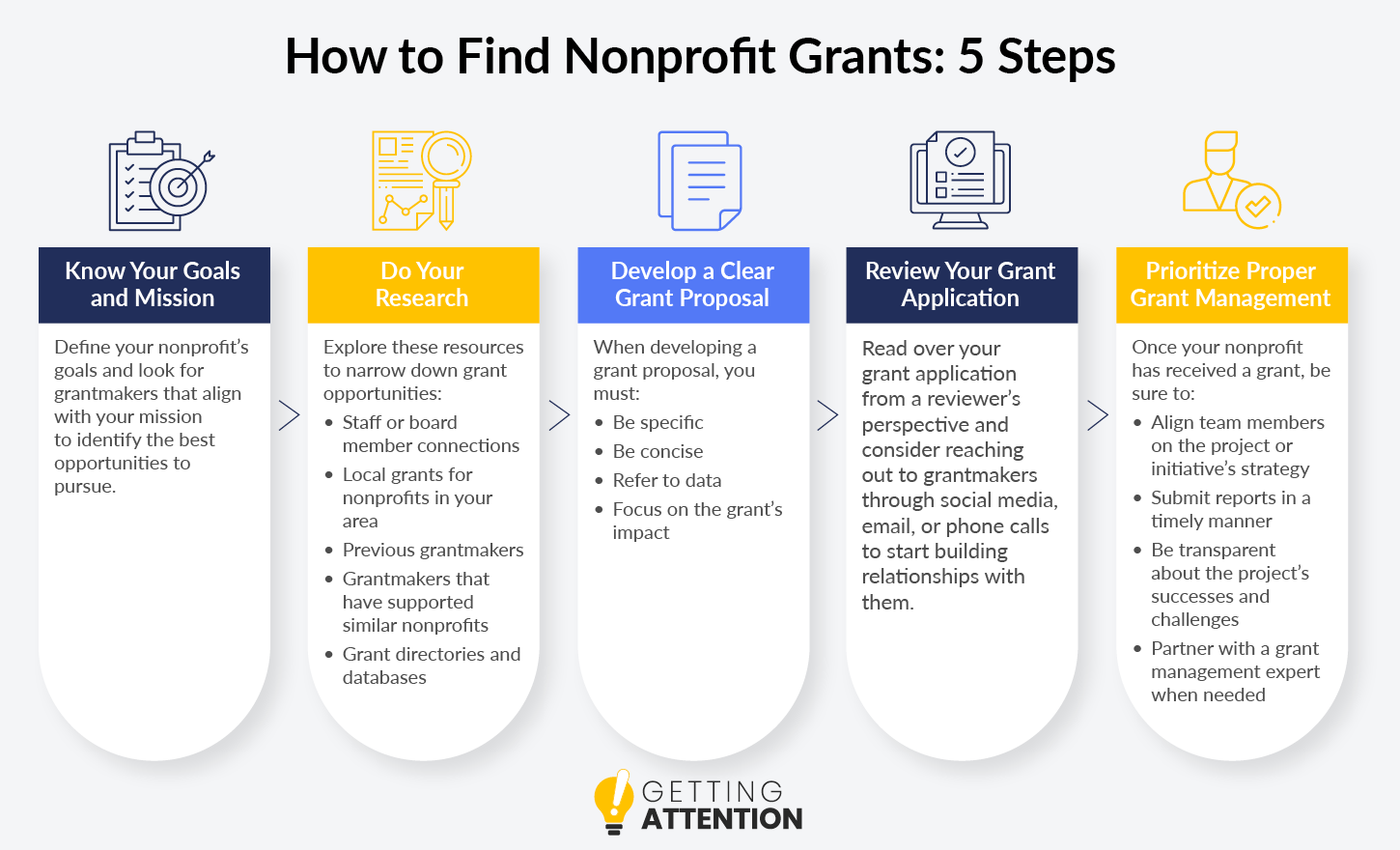
1. Know Your Goals and Mission
Take the time to clearly define your nonprofit’s goals. There may be numerous grant opportunities available, but only some of them will actually empower your organization to achieve those goals.
Additionally, keep your mission centered in your search. By finding grantmakers that align with your mission and values, you’ll increase your chances of securing the funds and avoid spending unnecessary time pursuing opportunities that don’t match your priorities.
2. Do Your Research
You’ll need to conduct some extensive research to narrow down grant opportunities that are suitable for your nonprofit. Get started by exploring some of these resources:
- Existing connections your staff or board members may have
- Local grants that only support nonprofits in your area
- Previous grantmakers that have supplied funding to your nonprofit
- Organizations that have provided grants to nonprofits similar to yours
- Grant directories and databases
When sifting through these sources, identify whether each grant meets your nonprofit’s needs and aligns with your mission. Additionally, it’s essential to have a specific budget outlined for the project or initiative you’re hoping to accomplish with grant funding. This will help you sift through opportunities more precisely and facilitate your application process down the line.
3. Develop a Clear Grant Proposal
As a grant applicant, it’s crucial to develop a proposal that demonstrates why your nonprofit is most deserving of the funds. Remember to:
- Be specific. State your organization’s goals and mission clearly. Be explicit as to how grant funding will help you to accomplish those goals by listing the specific projects or initiatives the funding will support.
- Be concise. Get right to the point in your application, so reviewers don’t feel the need to skim and potentially miss out on important details.
- Refer to data. Leverage your nonprofit’s data to highlight the impact you’ve already created in your beneficiaries’ lives, so grantmakers can understand the potential your organization has to make an even greater difference with more funding.
- Focus on the grant’s impact. Lay out the direct impact that you anticipate grant funds will empower your nonprofit to make in your community. This can also help you determine how you’ll measure these outcomes to comply with any reporting requirements.
The research you conduct will provide essential context that will guide your approach to each proposal. To further hone your proposal writing skills, consider searching for past successful applications online and making note of their strengths.
4. Review Your Grant Application
Before submitting your grant application, read through it from a reviewer’s perspective. This ensures that you don’t miss any important details that someone outside of your organization may need to understand your proposal.
Keep in mind that grantmakers will reference sources beyond your grant application to inform their decision. Therefore, be sure to demonstrate your nonprofit’s impact on your website, social media channels, and any other platforms reviewers may look at.
Furthermore, don’t hesitate to engage with grantmakers before submitting your applications. Whether you reach out through social media, email, phone calls, or in-person meetings, cultivating relationships with grantmakers can be crucial to securing funds both now and in the future.
5. Prioritize Proper Grant Management
After your nonprofit has received a grant, there are several best practices to follow to make the most of this opportunity. To optimize your outcomes:
- Ensure all of your team members understand the project or initiative’s goals, steps, and strategy.
- Submit reports in a timely manner.
- Be straightforward about successes and challenges throughout the project’s duration.
- Partner with a grant management expert when needed.
Effective grant management allows your nonprofit to build a positive reputation among grantmakers and maintain strong, productive relationships with organizations that have chosen to support you.
5 Best Practices for Finding Nonprofit Grants
Now that you understand how to find grants for nonprofits, explore these four best practices to maximize your success. The more preparation you invest in the process, the better your outcomes will be.
1. Look for Open Applications
One of the best-kept secrets in nonprofit fundraising is that many companies offer corporate grant opportunities with open applications year-round. These programs are often available through companies’ Corporate Social Responsibility (CSR) departments, employee volunteer initiatives, or local corporate foundations. Unlike traditional grants with strict deadlines, these open opportunities allow nonprofits to apply at their own pace, making them ideal for organizations that need funding flexibility.
To find them, start by visiting the CSR or community giving pages on company websites. Many list ongoing programs with simple online applications. You can also use tools like Double the Donation or other grant databases to search for companies known for continuous corporate giving. Plus, don’t forget to follow target companies on social media or sign up for their newsletters to stay in the loop about updates or changes.
The key? Stay proactive. Keep a list of companies that offer open grant applications and check in regularly. You’ll be surprised how many opportunities are waiting—you just have to know where to look.
2. Use the 3-Way Fit Test
The 3-way Fit Test is a useful tool for eliminating leads that are poor matches. The three ways are:
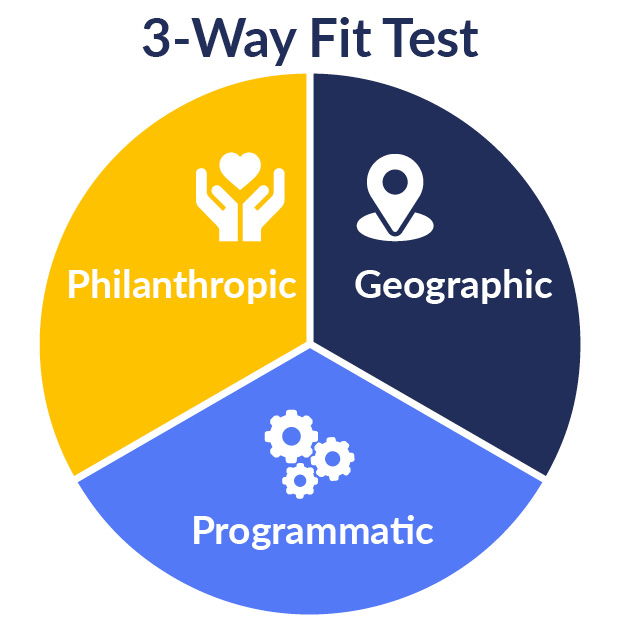
- Philanthropic fit. Make sure the grantmakers are offering the type of funding you are looking for, such as programs, projects, general operating support, or capital. This way, you’ll ensure that you receive the type of help you need.
- Geographic fit. Grantmakers typically choose to support nonprofits located in specific geographic areas. Focus on grantmaking organizations that fund the area you serve to increase your odds of winning the grant.
- Programmatic fit. Consider the funder’s mission, goals, and areas of interest, and ensure that they align with your own. For instance, if you’re planning to launch a new program to support people who are homeless, appeal to grantmakers with similar missions, rather than, say, an environmental organization.
By only concentrating on the grantmakers that fit all three of these criteria, your nonprofit will be able to spend its time and resources wisely to get the most out of your efforts.
3. Learn About the Funder
Beyond researching each specific grant’s requirements, it’s critical to learn more about the grantmaking organization. This will allow you to gauge its likelihood of funding your nonprofit and help you tailor your grant proposal to appeal to its specific interests. Review materials such as their IRS Form 990 and eligibility guidelines. For instance, Google lays out very detailed eligibility requirements for the Ad Grants program.
For grantmakers who don’t have all of their information in one centralized location online, use these questions to guide your research:
- What are their mission and current funding priorities?
- How much grant money or resources do they have available?
- What are their funding patterns?
- Do they encourage grant applicants to contact them beforehand?
These are just a few potential questions to consider, so feel free to expand on this list to uncover more details pertinent to your grant application process.
4. Build Meaningful Connections
While conducting your research, consider reaching out to the funder to ask any clarifying questions. Some baseline questions include:
- What is your selection process?
- Have your submission instructions undergone any recent changes not shown on your website?
- What is an appropriate amount to request in a proposal for someone who has never been funded by your organization?
Directly contacting the grantmaker will kickstart a meaningful relationship with the organization. This could give you an advantage when it comes time for the funder to review grant proposals, as you will be kept top of mind.
5. Recruit Expert Help
If your organization has limited time and resources to devote to finding nonprofit grants, consider recruiting a consultant to assist with your efforts. There are plenty of professional agencies dedicated to helping your nonprofit maximize the funding it receives to further its purpose. Getting Attention, for instance, is a Google Grants agency that can effectively get your organization up and running with the program.
If you’re interested in applying for the Google Ad Grants program and partnering with experts to handle the process, look out for key services such as:
- Google Ad Grant application assistance
- Google Grant account management
- Data tracking and ensuring compliance
Oftentimes, a nonprofit grant consultant will do all of the research and apply on your organization’s behalf, so you don’t have to worry about how to find grants that fit your specific needs. Just be sure to maintain open communication with your consultant so that everyone is on the same page.
Finding Grants for Nonprofits: 13 Resources
Ready to hit the ground running with finding nonprofit grants? Here are multiple resources to get you started:
Google Ad Grants
Google should be one of your nonprofit’s first stops when it comes to researching impactful grants to support your initiatives. The Google Ad Grants program provides eligible organizations with $329 in daily ad spending, or $10,000 a month, to bid on keywords that will promote essential pages on your website to current and potential supporters online.
Like any other grant, the Google Ad Grant comes with detailed eligibility criteria and a specific application process. To maximize your nonprofit’s chances of success, it’s best to prepare ahead of time and develop a thorough understanding of the program. Luckily, there are quite a few expert resources online for training you and your staff on Google Ad Grants.
Double the Donation
Double the Donation offers a corporate giving database with information on more than 24,000 companies’ giving programs—from matching gifts and volunteer grants to corporate grants, in-kind giving, sponsorships, and beyond. The database curates detailed profiles of these companies, including guidelines on eligibility, application deadlines, and the types of programs available. This makes it an incredibly useful—yet often overlooked—resource for grant researchers who want to explore the world of corporate philanthropy.
Grants.gov
Grants.gov contains over 1000 grant programs offered by all federal grantmaking agencies and allows you to search its database by selecting criteria such as eligibility requirements and category. Additionally, the website contains numerous guides such as FAQs and training videos for grant applicants.
Candid’s Foundation Directory
Candid’s Foundation Directory allows nonprofits to discover funders that may not be easily found on search engines. While you’ll need a subscription to access this resource, Candid offers its subscribers useful tools that assess whether a funder is a good match, track communications with funders, and more.
Philanthropy News Digest
Your nonprofit can search for published grant announcements on Philanthropy News Digest by signing up for a free weekly email that lists newly posted requests for proposals (RFPs). However, be sure to check other resources for more grant opportunities, since less than 1% of foundations publish RFPs.
Regional Giving Dashboards
Candid’s Regional Giving Dashboards provide at-a-glance information on top grantmakers and their funding priorities for 20 different states. You can click on each individual state to explore and even download this data for future reference.
Foundation Landscapes
By partnering with funders and philanthropy networks, Candid developed free custom web portals that display grants available to nonprofits focusing on select issues. These issues include human rights, disaster philanthropy, and early childhood care and education. Since these portals are constantly being updated, they can show you, in real time, the funders and recipients working in your nonprofit’s specific area of work.
Guidestar
The Guidestar directory includes a database of Form 990s. Additionally, you can find the names of nonprofits that a grantmaking organization funded during the filing period, the dollar amount given, and sometimes a brief description of the grant’s purpose. This can help you determine if the organization is likely to fund a nonprofit like yours, which can speed up the application process.
GrantStation
GrantStation is a funder database that produces two useful newsletters: a weekly one that lists recent U.S. grant opportunities and a monthly one that lists international grant opportunities. You can access these for free through other subscriptions/memberships, such as the Grant Professionals Association.
GrantsforUS
On the GrantsforUS website, you can find information about recently released U.S. grant opportunities that you can filter by different categories. Furthermore, you can sign up for free Grant Alerts to effortlessly stay up to date on grants that your nonprofit may be interested in.
Grant Gopher
Grant Gopher is a funding opportunity database that offers U.S. organizations free basic searches and access to the details of their first five search results. Additionally, you can access a newsletter covering a selection of open grant opportunities.
GrantWatch
GrantWatch is a directory of grants that are currently accepting grant applications. You can filter your searches by category, location, type of funding source, and recipient, though the website does charge a small subscription fee for you to access the specific details of each grant.
SAM.gov
This government grant directory provides a full listing of federal programs across all government agencies that provide grants, loans, or other types of assistance to organizations. You can search for relevant opportunities in the search bar and save or download any of your searches to refer back to later.
The Federal Register (FR)
The Federal Register announces newly authorized and/or funded programs, annual application deadlines, and award amounts for continuing programs daily.
Additional Resources
There is an abundance of grant opportunities for your nonprofit to tap into—what matters most is finding the best matches for your organization. While the process requires you to be thorough and precise, once you’ve mastered how to find nonprofit grants, you’ll be able to secure significant funds to power your growth and mission.
Remember that you don’t have to go through finding and applying for grants alone. Reach out to grant professionals, like Getting Attention, for first-rate guidance in maximizing your grant-seeking efforts.
To learn more about securing online support for your nonprofit, explore these additional resources:
- Nonprofit Advertising: The Essential Guide (With Examples!). This guide walks through all you need to know about spreading awareness of your organization and its cause through nonprofit advertising.
- Demystifying the Google Ad Grants Website Policy: A Guide. A high-quality website is not only essential for attracting and retaining supporters, but it can make all the difference in securing the Google Ad Grant for your nonprofit. Discover more in this guide.
- 9 Donor Engagement Strategies to Transform Your Outreach. Create strong and lasting relationships with your nonprofit’s donors by implementing these nine powerful strategies.
